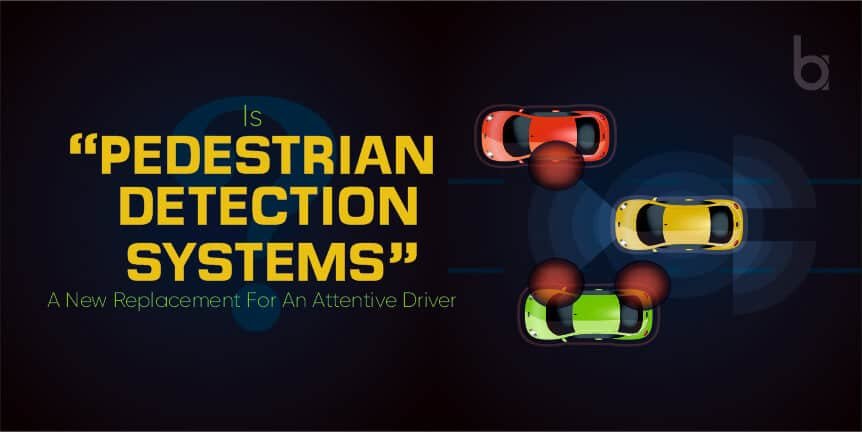Accidents have been one of the major causes of sudden deaths. To remedy the situation, technology is trying to upgrade the systems and bringing some aid to the crisis. The recent technology update is the pedestrian detection system, which automatically apply the brakes if a dangerous situation arises on the road. Autonomous cars are equipped with such a system that features cameras linked to the sensors in the front framework. These devices can respond to a dangerous situation much faster than a human can. The solution seemed effective but many still question the technology.
More about the Pedestrian Detection system
The system uses advanced sensors to detect human movements ahead and alert the driver. Some may automatically apply breaks. Stereoscopic cameras mounted behind the rearview mirror and radar has become operative at detecting the more refined movements of people. However, the systems are more effective at slower speeds. Pedestrian Detection may not always be an option to avoid a crash, but this feature can help reduce the speed enough to make the impact more survivable. As research develops, infrared technology will be a new addition to improve performance, especially at night.
Some of the key factors driving the growth of the market studied are the growing prominence on the safety of passengers and pedestrians due to the rise in the number of accidents and the increasing demand for the best vehicles. Besides, factors, such as difficulty in detecting pedestrians during bad weather conditions, may delay the growth of the market study. In recent years, the automobile industry has motivated its R&D work for improving the night vision systems. This has further led to improvements in advanced driving assistance systems, with the upwelling demand for nighttime pedestrian detection systems.
Low number of leading providers of advanced driving assistance systems in the emerging markets and the rise in the number of autonomous cars are reasons for the opportunities in the market.
Numerous strategies applied to the Pedestrian Detection System
Holistic detection- Detectors are programmed to scan the whole frame and search for pedestrians in the video frame. The detector would respond if the image features inside the local search window meet the criteria. The methods use global features such as edge templates. Similarly, others use local features like the histogram of oriented gradient descriptors. The performance, however, can be affected easily by background clutter and occlusions.
Part-based detection– Pedestrians are manufactured as collections of parts. A part hypothesis is firstly generated by learning local features, which include edgelet and orientation features. These part hypotheses are then joined to form the best combination of the existing pedestrian hypothesis. Part detection itself is a difficult task, though this approach is attractive. Execution of this approach follows a usual procedure for processing the image data that consists of first creating a densely sampled image pyramid, computing features at each scale, performing classification at all possible locations, and finally carrying out non-maximal suppression to generate the final set of bounding boxes.
Patch-based detection– Recently ‘Implicit Shape Model’ algorithm was introduced by combining both the strategies of detection and segmentation. The model comprises of three steps: During the training process, a codebook of local appearance is learned. Thereafter, in the detecting process, extracted local features are used to match against the codebook entries. Final detection depends on the obtained improve hypotheses. The benefit of this method is that only a small number of training images are required.
Detection using multiple cameras– A new method was suggested which may make use of multiple cameras to detect multiple pedestrians. To achieve this, the ground plane is partitioned into uniform, non-overlapping grid cells, typically with a size of 25 by 25 cm. The detector creates a Probability Occupancy Map; which provides an approximation of the probability of each grid cell being occupied by a person.
Benefits and limitation of the Pedestrian Detection system
A human can sense when there is something in the road and apply brakes immediately—but new technology can’t always pick up on these objects. With all of the new safety progressions making driving safer for pedestrians and motorists, it is important to note that there are limitations. These limitations comprise the lens sensor’s articulation of the actual object and/or person, the size and height of the person, time of day, weather conditions, and rapid response based upon the individual’s speed of movement. These are problems that create obstructions for those developing autonomous cars. In some cases, humans cannot always stop quickly enough when something comes on the road. If pedestrian technology can be fine-tuned to avoid items and people on the road, it will bring the best of both worlds together—human judgment and fast operating technology. Due to the constant differences of overpowering conditions, pedestrian detection technology must continue to be accompanied by cautionary and safe practices of the driver to reduce collisions.
Testing responsibilities after the system installations
As a tester, one should always pay attention and scan the road ahead looking for pedestrians or any obstructions. Understand how your car system works to exactly know how you will be warned if the system detects a pedestrian. Also, how the car may response i.e. automatic braking or would slow down to lessen the impact. Systems like the Pedestrian detection system are not a replacement to an attentive driver. Being a driver sometimes even you can’t expect what a person, especially a child might do. A computer can’t predict this either. Among the most dangerous times for pedestrians and drivers, twilight and dusk are one of them as the vision is greatly reduced during these hours.
To summarize, initially, the majority of the consumers did not adopt the systems, due to the high cost and lack of awareness. However, with the new regulations passed by the government and proven safety benefits, many are incorporating this technology. Nevertheless, being very dependent on the system may result in hazardous, one can’t rely on technology alone. With an autonomous car in progression, the pedestrian system would not be far away. Humans should embrace the technology usefully rather than loathing it fully with responsibility and later complaining that it failed them.
Read Full Magazine Business APAC Zealous Business Leaders of 2019





